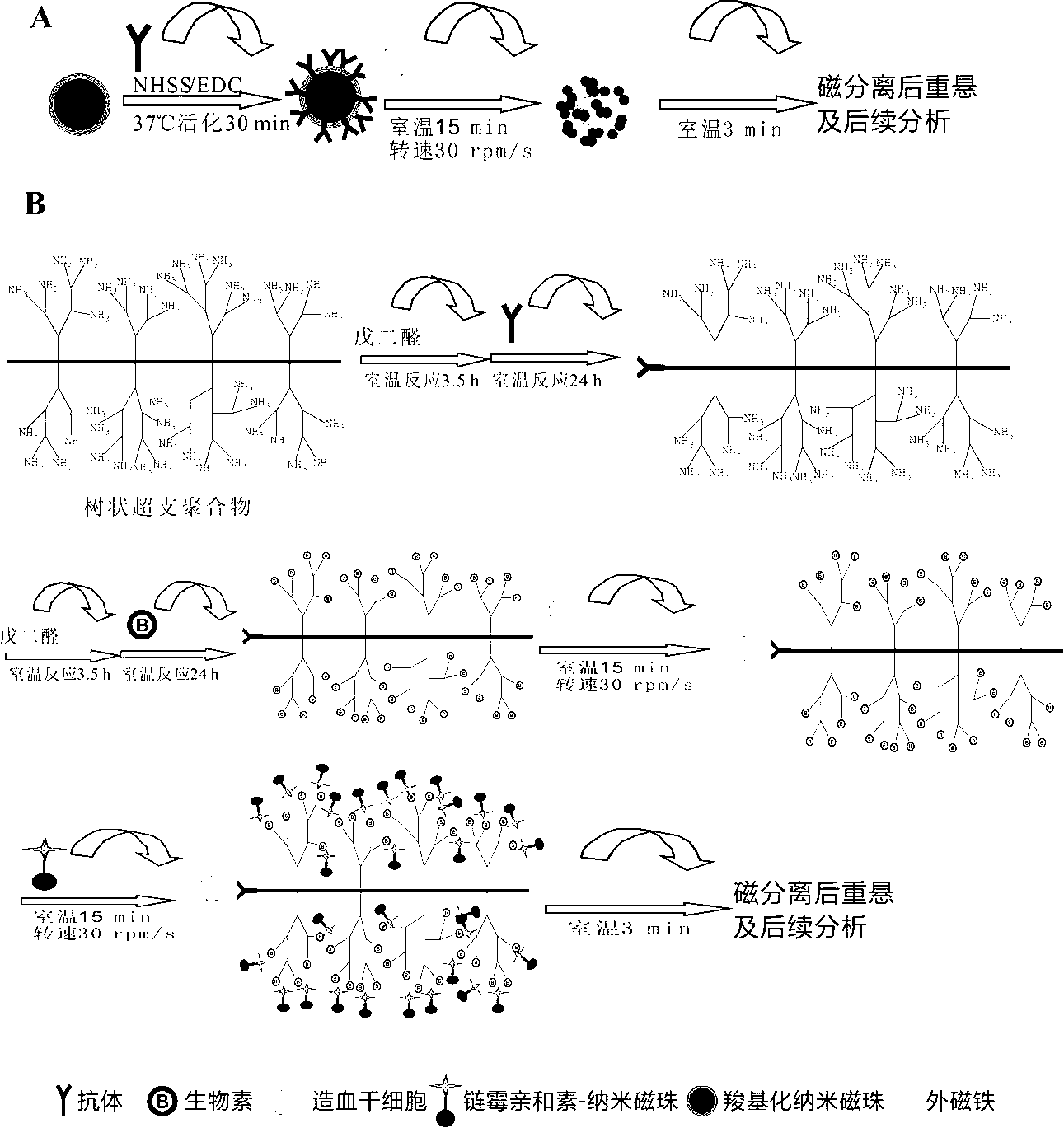Method for separating hematopoietic stem cells from human peripheral blood
A technology of hematopoietic stem cells and human peripheral blood, applied in the field of hematopoietic stem cell separation based on nano-magnetic beads, can solve the problems of spatial orientation change, change, poor monodispersity of micro-magnetic beads, etc., to increase the chance of contact, improve the separation efficiency, The effect of shortening the separation time
- Summary
- Abstract
- Description
- Claims
- Application Information
AI Technical Summary
Problems solved by technology
Method used
Image
Examples
Embodiment 1
[0029] 1. The dendritic hyperbranched polymer-antibody complex is prepared according to the following steps:
[0030] (1) Weigh 1.0 mg dendritic hyperbranched polyamidoamine aminated by dendrimer hyperbranched polymer, suspend in 4 mL phosphate buffer (PBS, 0.01 mol / L, pH 8.0), stir and add 25% of Add 545 μL of glutaraldehyde aqueous solution to make the final concentration of glutaraldehyde 3%. React at room temperature for 3.5 h at a rotating speed of 150 r / min on a shaker;
[0031] (2) Add 1 mL (ie 2.7 mg) of mouse anti-hematopoietic stem cell monoclonal antibody dropwise to the above solution to make the final concentration reach about 3 mg / mL. React at room temperature for 24 h at the speed of the shaker at 150 r / min;
[0032] (3) The above solution was spin-dried under reduced pressure, dissolved in deionized water, and dialyzed in PBS and deionized water for 1 day; after the dialysis, the obtained solution was freeze-dried.
[0033] 2. The long-chain biotin-d...
Embodiment 2
[0039] Example 2 Enrichment effect experiment
[0040] (1) Take 1 mL of concentration as 10 4 Cells / mL of hematopoietic stem cells were placed in a 1.5 mL sterile centrifuge tube, centrifuged at 12,000 rpm for 5 min, the supernatant was discarded, and resuspended with an equal volume of sterile PBS solution.
[0041] (2) Enrichment and capture: Set up the technical scheme group of the present invention (dendritic hyperbranched polymer group co-modified with hematopoietic stem cell antibody and long-chain biotin), nanomagnetic bead group modified with hematopoietic stem cell-specific antibody, and hematopoietic stem cell-specific Antibody-modified micron magnetic bead sets enrich target cells.
[0042] (3) After magnetic separation, pour the supernatant into a sterile centrifuge tube, and wash the isolated immunomagnetic beads with hematopoietic stem cells twice with PBST, mix well, and resuspend the immunomagnetic beads with 1 mL of sterile PBS solution. Magnetic bead compl...
Embodiment 3
[0056] Example 3 Enrichment capture experiment
[0057] Conventional magnetic stand separation time is 30min, and all the other are with embodiment 2.
[0058] The catch rate of each group is as follows:
[0059] Capture efficiency of hematopoietic stem cell-specific antibody modified micron magnetic bead set Capture efficiency of hematopoietic stem cell-specific antibody-modified magnetic nanobeads Capture rate of hematopoietic stem cell antibody and long-chain biotin co-modified dendritic hyperbranched polymer group 53.9% 42.7% 90.3%
[0060] The experimental results show that compared to the separation of 3 minutes in Example 2, when the separation time reaches 30 minutes, the capture efficiency of the three groups has been improved, especially the capture efficiency of the hematopoietic stem cell-specific antibody-modified nano magnetic bead group is the most obvious. It shows that the capture efficiency of the nano-magnetic bead group can be great...
PUM
| Property | Measurement | Unit |
|---|---|---|
| particle diameter | aaaaa | aaaaa |
Abstract
Description
Claims
Application Information
 Login to View More
Login to View More - R&D
- Intellectual Property
- Life Sciences
- Materials
- Tech Scout
- Unparalleled Data Quality
- Higher Quality Content
- 60% Fewer Hallucinations
Browse by: Latest US Patents, China's latest patents, Technical Efficacy Thesaurus, Application Domain, Technology Topic, Popular Technical Reports.
© 2025 PatSnap. All rights reserved.Legal|Privacy policy|Modern Slavery Act Transparency Statement|Sitemap|About US| Contact US: help@patsnap.com


